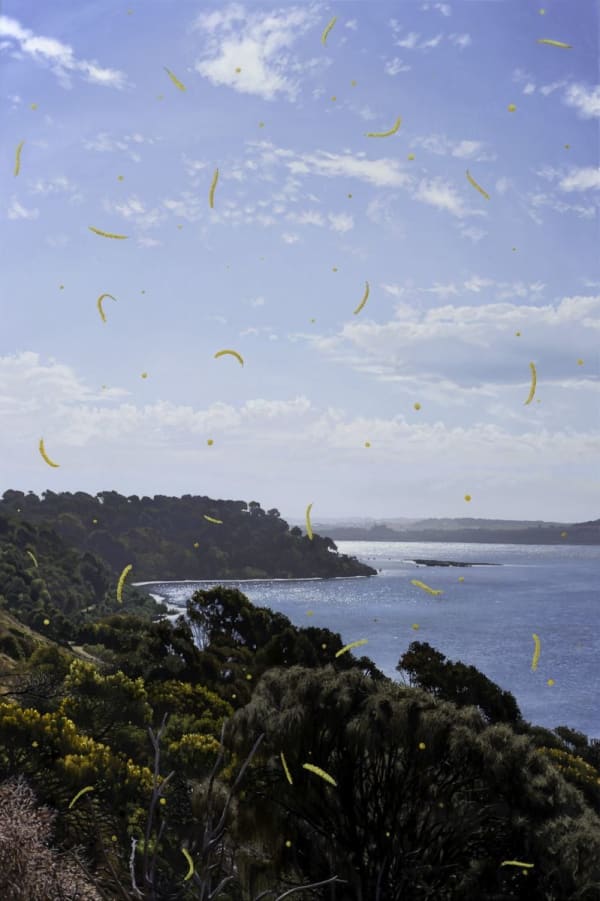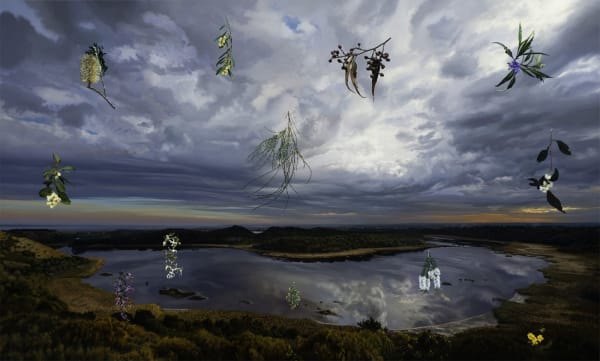Hobie Porter: Unnatural History: The Tower Hill Project
-
 Hobie PorterA Conflation of Acacias, 2015oil on polyester165.0 x 110.0 cm
Hobie PorterA Conflation of Acacias, 2015oil on polyester165.0 x 110.0 cm -
 Hobie PorterA Foreign Native / A Native Foreigner, 2015oil on polyester165.0 x 110.0 cm
Hobie PorterA Foreign Native / A Native Foreigner, 2015oil on polyester165.0 x 110.0 cm -
 Hobie PorterBleeding Manna Pattern, Tower Hill, 2014oil on polyester110.0 x 200.0 cm
Hobie PorterBleeding Manna Pattern, Tower Hill, 2014oil on polyester110.0 x 200.0 cm -
 Hobie PorterDisturbance, 2014oil on polyester120 x 180 cm
Hobie PorterDisturbance, 2014oil on polyester120 x 180 cm -
 Hobie PorterDrought in the Anthropocene (Acacia Decurrens), 2016oil on linen50 x 40 cm
Hobie PorterDrought in the Anthropocene (Acacia Decurrens), 2016oil on linen50 x 40 cm -
 Hobie PorterDrought in the Anthropocene (Corymbia Ficifolia), 2016oil on linen50 x 40 cm
Hobie PorterDrought in the Anthropocene (Corymbia Ficifolia), 2016oil on linen50 x 40 cm -
 Hobie PorterDucks Down, 2015oil on polyester100.0 x 120.0 cm
Hobie PorterDucks Down, 2015oil on polyester100.0 x 120.0 cm -
 Hobie PorterFrom Little Things, Big Things, 2015oil on polyester120.0 x 200.0 cm
Hobie PorterFrom Little Things, Big Things, 2015oil on polyester120.0 x 200.0 cm -
 Hobie PorterLeaf Carpet, 2016oil on linen35.5 x 30.0 cm
Hobie PorterLeaf Carpet, 2016oil on linen35.5 x 30.0 cm -
 Hobie PorterMuun Gnamatt, Tower Hill Game Reserve, 2014oil on polyester110 x 200 cm
Hobie PorterMuun Gnamatt, Tower Hill Game Reserve, 2014oil on polyester110 x 200 cm -
 Hobie PorterOf Middens and Dumps, 2015oil on polyester110.0 x 200.0 cm
Hobie PorterOf Middens and Dumps, 2015oil on polyester110.0 x 200.0 cm -
 Hobie PorterTower Hill Lament, Not All Boomerangs Come Back, 2014oil on polyester110 x 200
Hobie PorterTower Hill Lament, Not All Boomerangs Come Back, 2014oil on polyester110 x 200
cm -
 Hobie PorterTower Hill Lament, not all Boomerangs Come Back, 2014oil on polyester canvas110 x 200 cm
Hobie PorterTower Hill Lament, not all Boomerangs Come Back, 2014oil on polyester canvas110 x 200 cm -
 Hobie PorterWhite Fella Midden , 2015oil on polyester69.0 x 122.0 cm
Hobie PorterWhite Fella Midden , 2015oil on polyester69.0 x 122.0 cm
‘Unnatural History: The Tower Hill Project’ commemorates 160 years since Australian artist Eugene von Guérard painted Tower Hill (1855). Employing his characteristic photorealist aesthetic, Porter interrogates the environmental impacts that colonial settlement has had on this special place. Since von Guérard’s celebration of Tower Hill, its natural vegetation was cleared for various purposes including farming, quarrying and firewood. It has been used as a dump, a wastewater drain, a motor-cross, and serves to this day as a reserve for duck shooters. Guided by von Guérard’s painting, a major revegetation program began in the 1960s to restore the flora and fauna native to the region. This has been successful to a point. Porter’s depiction of Tower Hill celebrates this renewed state, while also alluding to the complexities of the restoration program.
Sublime panoramic landscapes are overlaid with configurations of the minutiae that the artist discovered while exploring these sites. Feathers, leaves, flowers, botanical specimens, ceramic shards and beach shells (often used to represent Aboriginal midden shells) – forge meaningful connections between the microcosm and the macrocosm. These objects are often photographed, painted and replaced on site so as not to disrupt their place in heritage or ecology. In the works, the soaring constellations of clouds emblemise transience and impalpability, a poetic contrast to the enduring landscape of Tower Hill. Ultimately, while hinting at anthropogenic impacts of loss and neglect, displacement and imposition, the paintings also point towards transcendence, resilience and redemption via an essential harmony between nature and culture.


















